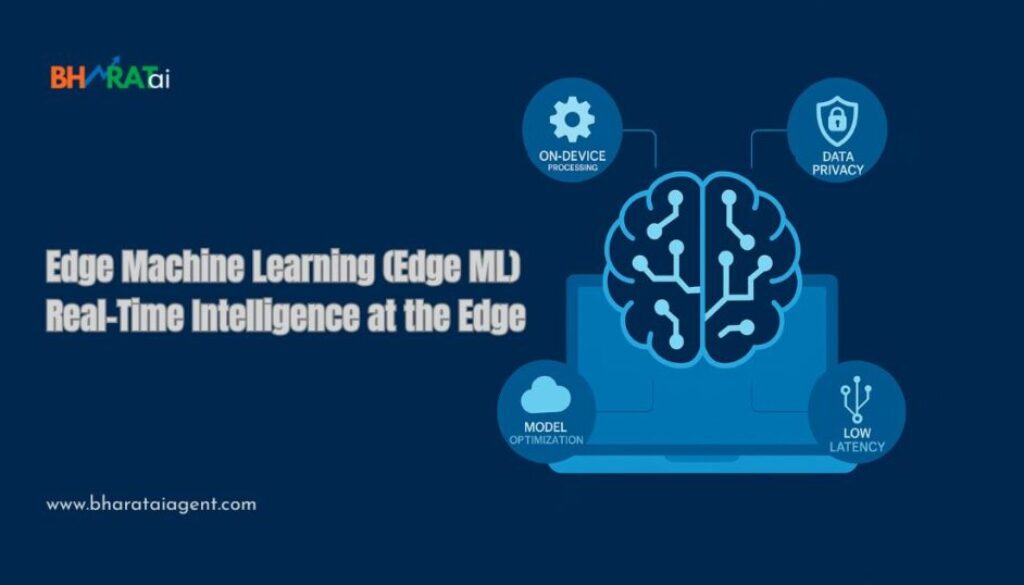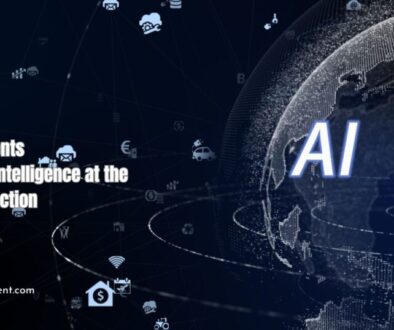Edge Machine Learning (Edge ML) in 2025: Real-Time Intelligence at the Edge
Introduction
In an increasingly connected and data-driven world, Edge Machine Learning (Edge ML) has emerged as a critical innovation in 2025. By enabling machine learning (ML) models to run directly on edge devices—such as smartphones, IoT sensors, drones, and cameras—Edge ML delivers real-time insights, low-latency responses, and privacy-first processing.
-
What is Edge ML and how does it work in 2025?
-
What are the benefits and challenges of Edge Machine Learning?
-
How is Edge ML used in healthcare, manufacturing, and smart devices?
What is Edge Machine Learning (Edge ML)?
Edge ML refers to the deployment and execution of machine learning models on edge devices (i.e., devices close to the data source), rather than in the cloud or centralized data centers.
Instead of sending all raw data to the cloud for processing, Edge ML allows:
-
✅ On-device data analysis
-
✅ Instant decision-making
-
✅ Offline or intermittent connectivity operation
-
✅ Reduced data transmission
-
✅ Enhanced data privacy
This paradigm is essential for real-time, privacy-sensitive, or remote applications—especially in healthcare, manufacturing, automotive, smart homes, and industrial IoT.
How Edge Machine Learning Works
-
Model Training
ML models are trained on large datasets in the cloud using powerful GPUs or TPUs. -
Model Optimization
Models are compressed using techniques like quantization, pruning, and knowledge distillation to run efficiently on limited hardware. -
On-Device Deployment
Optimized models are deployed to edge devices via platforms like TensorFlow Lite, PyTorch Mobile, or ONNX Runtime. -
Real-Time Inference
Devices make predictions or decisions locally using new input data, without sending it to the cloud.
Key Components of Edge ML Systems
-
Edge Hardware: Microcontrollers, SBCs (Raspberry Pi, NVIDIA Jetson), mobile chips (Qualcomm, Apple Silicon)
-
ML Frameworks: TensorFlow Lite, Edge Impulse, PyTorch Mobile, TVM, OpenVINO
-
Model Compression Techniques: Quantization, pruning, neural architecture search (NAS)
-
Deployment Tools: MLOps for edge (NVIDIA Fleet Command, AWS IoT Greengrass, Azure Percept)
Benefits of Edge Machine Learning
🚀 1. Ultra-Low Latency
Edge ML allows devices to respond in milliseconds, which is crucial for time-sensitive applications like autonomous vehicles or industrial robots.
🔒 2. Data Privacy & Compliance
Since sensitive data doesn’t leave the device, Edge ML helps comply with privacy laws like GDPR, HIPAA, and India’s DPDP Act.
🌐 3. Offline Functionality
Edge ML enables devices to work in remote or low-connectivity areas—ideal for agriculture, defense, and logistics.
⚡ 4. Lower Bandwidth Usage
Only processed results are sent to the cloud (if at all), reducing costs and network strain.
🔋 5. Energy Efficiency
Optimized models run on low-power devices, enabling battery-powered wearables and sensors to use AI without frequent recharging.
Real-World Use Cases of Edge ML in 2025
🏥 Healthcare
-
Wearables detecting anomalies (e.g., heart rate irregularities)
-
AI diagnostic tools in remote clinics for instant disease detection
🚘 Automotive
-
Driver monitoring systems using real-time vision models
-
Vehicle-to-everything (V2X) interactions for smart traffic responses
🏭 Manufacturing & Industry 4.0
-
Predictive maintenance through real-time vibration and temperature analysis
-
Defect detection on assembly lines using computer vision
📱 Smartphones & Consumer Devices
-
On-device voice assistants, language translation, photo enhancement, and augmented reality
🌱 Agriculture & Environment
-
Soil quality monitoring and crop health prediction using edge AI sensors
-
Forest fire detection systems running in isolated locations
🏠 Smart Homes
-
Cameras with local facial recognition and motion detection
-
Voice-activated appliances that don’t need cloud access
Edge ML vs. Cloud ML: A Quick Comparison
| Feature | Edge ML | Cloud ML |
|---|---|---|
| Location of Processing | On-device | Remote data centers |
| Latency | Millisecond-level | High, depends on network |
| Connectivity | Works offline or intermittently | Requires always-on internet |
| Data Privacy | High (no external transmission) | Data often sent to third-party cloud |
| Use Cases | Real-time, privacy-sensitive | Large-scale training and storage |
Latest Innovations in Edge ML -2025
Edge devices collaboratively train models without sharing raw data—ideal for healthcare, finance, and personalized AI.
🧠 Neuromorphic Chips
Brain-inspired processors (e.g., Intel Loihi, IBM TrueNorth) now power Edge ML with higher efficiency and lower power draw.
🔍 Edge AutoML
Automated model selection and optimization for edge deployment using platforms like Edge Impulse and Google Coral AutoML.
📦 Model Zoo for Edge
Open-source libraries like Hugging Face, Edge AI Zoo, and OpenVINO now offer hundreds of ready-to-deploy tiny models.
Challenges & Limitations
🔋 Power & Compute Constraints
Running deep learning models on microcontrollers requires significant optimization.
⚠️ Model Accuracy vs. Size Trade-off
Smaller models may lack the accuracy of larger cloud-based models, especially in nuanced tasks.
🔐 Edge Security
Local devices must be hardened against physical tampering and software exploits.
🔄 Model Updates
Updating deployed models across thousands of distributed devices can be complex without MLOps for edge.
Future Trends in Edge ML
-
🌐 5G + Edge ML Synergy: Real-time intelligence for smart cities, autonomous fleets, and emergency services.
-
🔁 Self-Learning Edge Devices: Edge agents that learn on-device and improve with time.
-
🧠 Hybrid AI Systems: Combining edge and cloud inference dynamically based on context and compute requirements.
-
🔋 Energy-Aware ML Models: Algorithms that adjust complexity based on battery status or power availability.
FAQs: Edge Machine Learning (Edge ML)
**Q1: What is Edge ML in simple terms?
Edge ML is when machine learning models run directly on devices like phones, sensors, or drones—allowing them to make decisions instantly without needing the internet or cloud.**
Q2: How does Edge ML differ from Edge AI?
Edge ML refers specifically to machine learning at the edge, while Edge AI can include other types of AI (e.g., rule-based logic, computer vision without ML).
Q3: Is Edge ML only for large enterprises?
No. Startups and small businesses use platforms like Edge Impulse, Google Coral, and TinyML to build Edge ML solutions affordably.
Q4: What programming languages are used for Edge ML?
Python (for training), C/C++ (for deployment), and domain-specific languages (e.g., TensorFlow Lite for Microcontrollers).
Q5: Can Edge ML models be updated remotely?
Yes, using MLOps pipelines and tools like AWS IoT Greengrass, Azure IoT Hub, or OTA (Over-the-Air) updates.
Conclusion
Edge Machine Learning in 2025 is enabling a new era of real-time, privacy-first, and responsive intelligence—right where the data is generated. Whether it’s a health wearable, an industrial robot, or a smart home device, Edge ML ensures that decision-making is fast, local, and secure.
Organizations that adopt Edge ML today are building the future of intelligent, decentralized systems that scale seamlessly across industries and geographies.
#EdgeML #MachineLearning #EdgeComputing #TinyML #AI2025 #FederatedLearning #OnDeviceAI #SmartDevices #AIoT #RealTimeAI #PrivacyFirstAI
Edge Machine Learning 2025
Edge ML use cases
Edge AI vs Edge ML
Federated learning at the edge
Edge ML platforms
Real-time machine learning
TinyML applications
ML model compression
IoT edge analytics
Edge computing with AI
What is Edge ML
Benefits of Edge ML
Edge ML vs cloud ML
ML on Raspberry Pi
Edge ML hardware
TensorFlow Lite deployment
PyTorch Mobile examples
Edge AI in agriculture
Edge ML for healthcare
Smart camera AI inference



